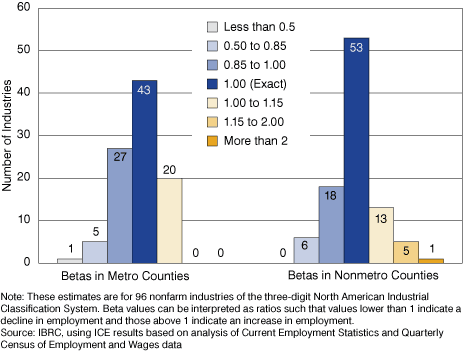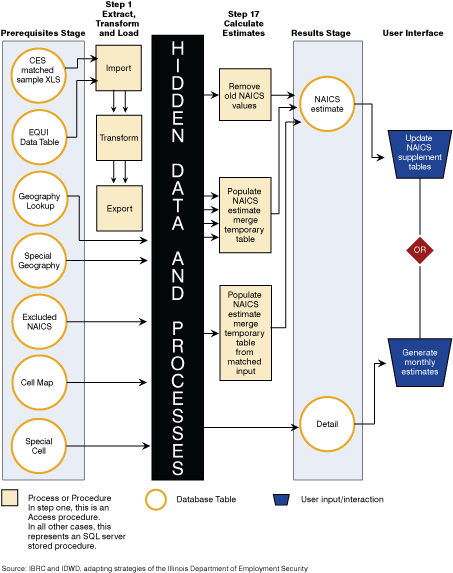Expanding Indiana's Monthly Employment Data
This research brief summarizes efforts to further expand Indiana's Current Employment Statistics (CES) program to produce monthly super-sector employment estimates at the county-level. Currently, such detailed figures are only available quarterly with a six-month lag through the Quarterly Census of Employment and Wages (QCEW) through its comprehensive survey of employers throughout the state. It is a challenging task to make monthly projections of local super-sector employment given the small size of many counties and the rapidly changing labor market. However, over the past year, the project team from the Research and Analysis Division of the Indiana Department of Workforce Development (DWD) and the Indiana Business Research Center (IBRC) have been working to adapt the strategy used by the State of Illinois—the only other state to produce such estimates.1 These efforts to form the Indiana County Estimator (ICE) stand to produce an “early intelligence” tool that would greatly assist government officials and local economic developers in their efforts to rapidly address changes in the labor market.
The Methodology in Brief
In developing ICE, the research team modified the strategy used by the Economic Information and Analysis Division of the Illinois Department of Employment Security and their collaborators at the University of Chicago's National Opinion Research Center (NORC). These Illinois researchers were kind enough to share their documentation and even offer some initial advice by phone.
The overall technique is to use the change in “current” employment for firms in the relatively small sample surveyed monthly through the CES program to project the employment of all Indiana firms using data reported previously through quarterly tax filings. Of course, there are many intermediate tasks to successfully and securely implement such a procedure given the millions of confidential employment records. Extensive coding in Microsoft SQL Server Integration Services (SSIS) is used to assemble, parse and match data from multiple secure servers hosted by state government as well as to run statistical estimation procedures.2 Ultimately, a user-friendly computer interface will be created that will allow DWD analysts to automate and make adjustments to the entire procedure whenever new data are available. Figure 1 summarizes the beginning and end stages of the process by showcasing some of the procedures and types of data involved.
Figure 1: Data Flow Diagram Summarizing the Beginning and End Stages of the Indiana County Estimator (ICE) Process
Key Steps in the ICE process
- CES employment for sample establishments for the current month (e.g. March 2009) are matched with QCEW employment for the same establishments one year earlier (March 2008).3
- The sample establishments' employment is then aggregated in two key ways:
- By industry based on the 96 sectors classified through the three-digit codes of the North American Industrial Classification System (NAICS)
- By whether or not they are located within a Metropolitan Statistical Area (metro)
- Beta estimates (β) are obtained as the factor by which QCEW employment for each industry are multiplied to accurately reflect aggregate CES employment for the sample (or “certainty”) units. This estimation is made using ordinary least squares (OLS) regression and is loosely based on the following formula:

where n211, n212, etc. represent each three-digit NAICS industry. - Beta estimates are then refined in three key ways:
- Beta coefficients that are not statistically significant (i.e., have a likelihood of error higher than 5 percent) are replaced with the value of “1.” This means they essentially default to a 1-to-1 ratio.
- Beta coefficients that are based on a sample of firms fewer than four for a particular industry are also replaced with a value of “1.”
- Employment estimates by county for each three-digit NAICS industry (96 industries in all) are created as the sum of the following:
- The actual employment for each establishment that is reported by the CES sample (certainty units).
- The estimated employment (using the beta estimates for each industry) for establishments that are not in the CES sample (non-certainty units).
- The supplemental employment figures for “presumed non-covered” workers. These are workers that are not counted by the QCEW, including elected officials, railroad workers and student workers at colleges and universities. DWD already creates regular estimates of these workers based on supplemental data it requests from relevant employers.
- To reduce the volatility of the estimates, employment figures are then produced for 11 super-sectors by aggregating employment estimates of the 96 NAICS sectors to the super-sector structure used for Current Employment Statistics reporting.
Results of Initial Testing
To test the reliability of ICE results, the research team produced estimates for historical periods to see how well projections matched actual reported employment. Specifically, the research team made employment estimates for every month of 2007 using data from 2006. Figure 2 summarizes the ranges of the Beta coefficients produced for November 2007. Many estimates had the conservative value of 1 meaning no change in employment between 2006 and 2007 for that industry. However, slightly more coefficients were between 0.85 and 1.00 rather than between 1.00 and 1.15—indicating that more industries had a modest decline in employment rather than a modest incline.
Figure 2: Beta Coefficient Ranges for Projected Employment Change for Nonfarm Industries in Indiana's Metro and Nonmetro Counties, November 2006 to November 2007

Figure 2 also reveals the increased challenge of projecting employment in nonmetro counties. ICE projections not only assigned more industries in these regions with the default beta value of 1 (meaning no change in employment) but more industries were assigned extremely low (less than 0.85) or high beta values (greater than 1.15)—indicating unusually large shifts in employment.
Overall, the ICE estimates are highly accurate in projecting total employment. November 2007 test results show that, on average, ICE total employment estimates were within 2.5 percent of the actual employment figures confirmed by QCEW establishment reporting. However there are still several counties, mostly outside of metros, with fairly large differences between the estimates and actual employment figures. For example, estimates for Newton, Ripley and Union counties were off the mark by more than 8 percent.
To improve ICE estimates for industrial sectors, the research team is working on ways to allow labor market analysts the chance to investigate large shifts in employment within counties. This is crucial to ensuring that employment shifts reflect the actual changes of particularly influential establishments that may be major employers within small counties. Data error is possible since administrators at establishments with multiple locations sometimes mistakenly provide combined employment figures instead of separately reporting data for each operation by county location. Furthermore, if shifts in employment within a particular county are valid yet particularly unusual and non-representative of other metro or nonmetro counties, the ICE modeling procedure should be adjusted accordingly.
Conclusion and Future Plans
Currently, the research team is doing a final round of testing by projecting 2008 employment figures before beginning employment projections for 2009. Additionally, important work is needed in order to automate the entire process with a user-friendly interface, along with editing capabilities that state analysts could use on a monthly basis. While employment projections are never perfect and need to be used with caution, ICE can lend important insight for leaders required to make urgent workforce investment decisions.
Notes
- More information about Illinois's small area employment estimates can be found in: Joseph Malcolm's “Nonfarm Employment Estimates for Smaller Areas (Part 2)” Illinois Labor Market Review: 8 (3).
- Currently, the research team is in the process of automating the statistical estimation process using either Stata or SPSS software.
- While the Illinois strategy called for matching CES employment with the most recent benchmarked QCEW figures, the research team decided it was better to use the same month in the prior year to avoid the need for seasonal adjustments.
Michael F. Thompson, Economic Research Analyst
Indiana Business Research Center, Kelley School of Business, Indiana University
Jackie V. Turner, Database Analyst/Programmer
Indiana Business Research Center, Kelley School of Business, Indiana University

